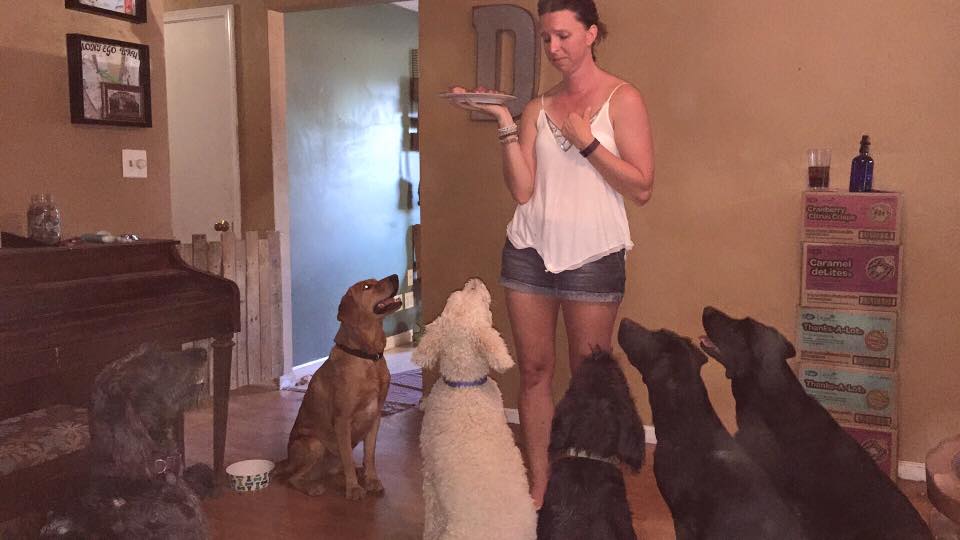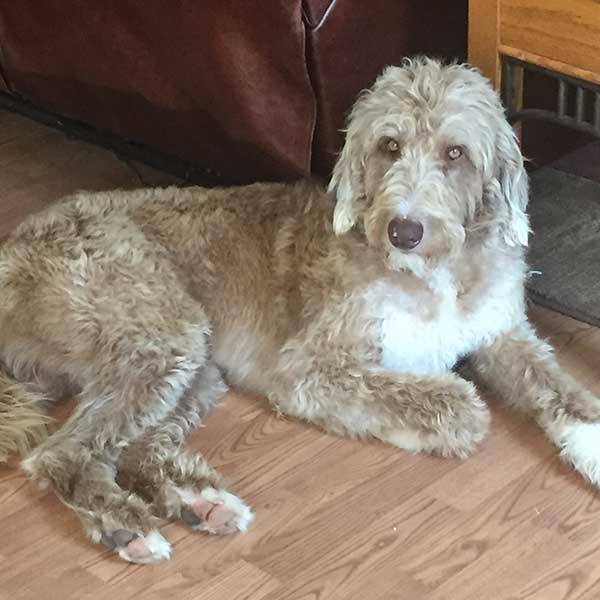As breeders we are often asked what the best methods of training our dogs are. I think before we get to that we need to understand more about HOW dogs learn and think. Obviously, dogs aren’t human and they do not think or learn in exactly the same way we do. Dogs perceive far more of their world through sight and smell than we do. Their sense of smell is incredible and they are amazingly perceptive of visual cues and body language. They are also social learners, capable of learning behaviors from other dogs or people by simply watching. I’ve found that for me, one of the easiest ways to house train my pups is to let them out with my adult dogs for potty breaks. The pups see what the adults do and learn to mimic their behavior. This is an example of social learning. My lab also taught a couple of our other dogs to open the baby gates we put up to keep them out of rooms. She figured out the lock mechanism and her friends learned by watching her. Now I need better gates. This is the same way several of my dogs learned to open the doors to some of our kennels. Siren figured it out and then they watched her and learned from her.
Another thing we have to understand is that dogs are individuals with needs of their own. They have needs for food, shelter and rest but also for mental stimulation and physical exercise. It is often when we are not adequately meeting those needs that our dogs act on their own. This might include chewing up your favorite shoes, pulling your houseplants out of the pots, shredding the paper towels. Then, when we get upset and lock our dogs away from these items, they can become frustrated. When we see aggression in dogs it is often from this frustration of not having their needs met because their family simply doesn’t understand what those needs are.

Dogs tend to pick up hand signals faster than verbal cues.
Dogs also tend to pick up hand signals faster than verbal cues. If you want quicker results, pair a hand signal with the verbal cue for the behavior you are teaching. An added benefit with hand signals is that if your dog can’t hear you but can see you he can still accurately perform the behavior you are asking for. I trained my border collie with hand signals for long distance cues. He could perform several tasks from 50-100 yards away because he was able to clearly see me even if he couldn’t hear what I had said. This is excellent for off lead work when your dog may not be right next to you.

Once we have understood that our dogs are visual learners and we are sure we are meeting their needs, we can move on to proper training.
Most dog positive training relies heavily on operant conditioning. The dog performs a behavior and gets a reward typically if we want the behavior to increase or become consistent. We can also see the dog perform an unwanted behavior and this may result in a reward going away.. ie. Your dog jumps on you and you turn away and ignore him. These are examples of operant conditioning and are typical training methods used to teach dogs behaviors like sit, stay, down, etc. The basic commands we want them to learn.
This positive training method is much preferable to some of the more old school methods that may have included alpha rolls, mimicking bites in order to teach a pup not to bite, etc. Dogs are not stupid. They know you aren’t a dog, which means they know you aren’t the “alpha”. You don’t have fur or sharp teeth, you can’t run very fast, you can’t jump very high, you walk on two legs and wear clothes. You’d honestly make a terrible dog and they can clearly see this when they look at you. That does not mean they don’t respect you but there is no benefit to the above listed behaviors unless you really just want to confuse and intimidate your dog.

Remember, before you alpha roll your dog, or scream at him, or worse, that he has 42 teeth and a bite force capable of breaking bones but he doesn't use them to bully or intimidate you.
He may be your sweet family pet but that is because he has chosen to respect you, love you and try to learn the rules of our society. He is still, under that cute fluff, an apex predator. I think we tend to forget that sometimes because dogs are so forgiving of all of our missteps and outbursts. Then we see news stories about dogs turning on their owners and I have to wonder who is at fault. So… the take away here is operant conditioning is the key to most positive dog training. If you aren’t familiar with it there are two techniques. You should learn these if you want to have a successful relationship with your dog.
- Reward training. This means that in order to have your dog perform a wanted behavior, you offer a reward. This can be a treat, a toy, freedom to roam, playtime, a snuggle or pat on the head. Basically it is something your dog wants that is pleasurable. He performs the behavior and gets his reward thus he is more likely to perform the behavior again. Reward training is our preferred method for teaching our dogs and puppies. You are building trust and a relationship with your dog while using reward training. This sets you and your dog up for a positive relationship and makes the training so much more enjoyable for both of you.

2. Aversive training – this means that when your dog performs an unwanted behavior or fails to perform the wanted behavior, something unpleasant happens. This could be a collar correction, a slap on the muzzle, a stern word, an unpleasant sound etc. The use of this method is not recommended with any frequency. We don’t want to overcorrect our dogs or they get used to the aversive stimulus and it becomes less effective. I would save this method for really stubborn dogs and dangerous behaviors personally.

Timing of the stimulus is key.
Whichever method you end up with, or often a combination, it is important to understand that so much of a dog’s learning depends on the timing of the stimulus. We want the positive or the aversive stimulus to happen as close to the behavior as possible so that the dog associates it with the behavior. This is why you will hear trainers tell you not to yell at or punish your dog if he has an accident in the house and you don’t find it until later. If you catch him in the act they may tell you to make a loud noise or distract him to get him to stop. But if you find a puddle on your floor that happened minutes or hours ago and you go yell at your dog for it, he is not associating the behavior (peeing on the floor) with the aversive stimulus (your yelling). He is simply confused and scared about why you are angry with him. Timing is key and is something you will need to practice.
I also recommend finding a good trainer in your area to work with. This way you can simply ask if you are having trouble with a behavior or having trouble getting the timing right. I would ask at your local vet clinic if they can recommend a trainer and be sure you speak to them regarding their methods before agreeing to use them. I prefer those who are using mainly positive reinforcement and reward based training to those who use more aversive techniques like prong collars and e-collars. The aversive techniques may work more quickly for some problem dogs but there are plenty of dogs out there whose temperaments can’t handle that type of training. I would personally rather the training take longer and know that I am building a foundation of trust and mutual respect than one of fear and avoidance of pain. The prong collar may indeed change your dog’s behavior but that is simply because the dog wishes to avoid the uncomfortable feeling of the prongs on his neck, not because you’ve gotten to the root of the problem in the first place. I am sure there are trainers out there who would disagree but lets say my dog has a strong tendency to pull on his leash while on walks. A prong collar would definitely fix that problem quickly because if he pulled on this leash, the collar would tighten a little and the prongs would put pressure on his neck making him uncomfortable. Short term it curbs the problem but it doesn’t get to the root of why he was pulling so much to start with. Another method to teach him not to pull would be to simply stop walking each time he pulls or to teach him the heel or watch me cues. This may take a bit longer to be effective and walks may take longer at first but in the end you will still get a dog that walks nicely on a leash. Bonus, you won’t have caused him discomfort or inadvertent pain by using the pronged collar. You’ll have a dog that walks nicely for you because it is pleasant for both of you and because he wants you to be happy with him, not because he wants to avoid discomfort
